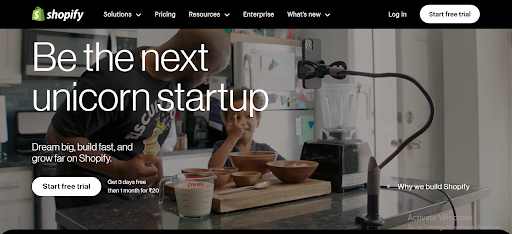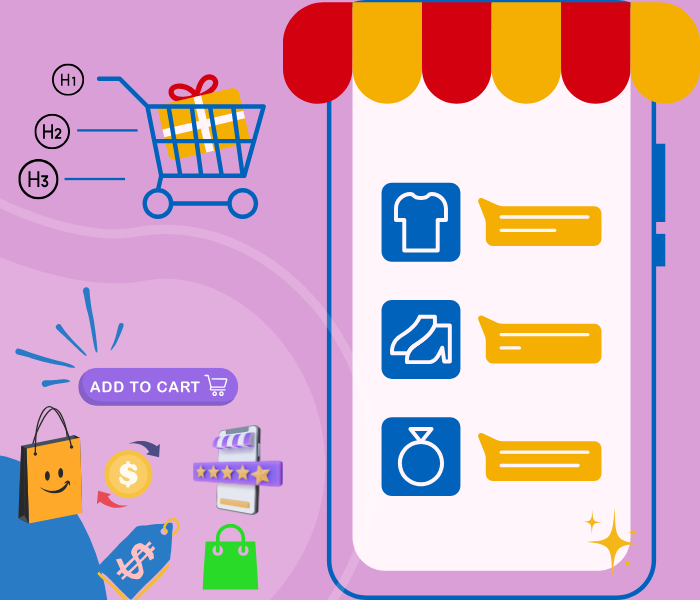3 Nov 2024 |
By - Sudha Mariappan

Shopify is the best way to pursue your entrepreneurial journey, whether through online or offline. It is used by a variety of businesses, from small entrepreneurs to globally acquired brands.
The website landscape is very simple, as it helps people to easily set up their business with their simplified Search engine Optimization.
With Shopify SEO, you can make sure that you have more visibility of your store in search engine results and organic traffic.
Since Shopify is very flexible, you have an opportunity to modify it according to your needs so that the changes directly impact your rankings.
Here are key areas: optimize URLs, product descriptions, images, and metadata.
It ensures that your product is better understood by the search engine, thereby improving rank. High-value keywords on your product pages and collections improve the relevance of search, thus making it more probable to find you.
Quality content creation, such as product descriptions and blog posts, is also important. Content that answers customers' needs, such as buying guides, comparisons, increases engagement and credibility.
Shopify On-page SEO

On-page SEO is crucial to ensure that your products get to the targeted audience, thus generating organic traffic, in a Shopify store.
Again, on-page SEO contrasts technical SEO, which pertains to the site performance and structure. On the other hand, on-page SEO mainly deals with the elements applied to each page, such as descriptions of the products, the optimization of images, headings, and the keywords applied. These elements will give search engines clues on what every page contains, therefore helping them rank in a much easier way. See this detailed guide to how to optimize on-page elements for Shopify SEO.
1. Create Creative Product Descriptions
One of the most important on-page search engine optimization elements is unique, creative, and keyword-rich descriptions of your products. Never duplicate the descriptive copy from your competitors or suppliers, as duplicated content can also harm your rankings.
Every product description should answer all relevant customer questions, introduce benefits, and inject the targeted keyword as a way of flavoring without keyword stuffing.
Instead of saying that a product is "high quality," describe the particular benefits that are going to accrue to a customer: "This sleek and functional tote bag is designed to work with you every day, combining durable, sustainable materials for maximum functionality and lasting quality."
Descriptive keyword-optimized copy engages the customer and sends relevant signals back to the search engine as well.
2. Image Optimization
Image is an integral part of e-commerce, but unoptimized images will slow down your site, and this can hurt your SEO. Shopify natively supports efficient formats like WebP—they are lightweight in size without losing quality.
Compressed images load faster and aid in a smooth user experience. Besides this, every image should have proper descriptive alt text with the right keywords. Alt text is not only for boosting SEO but also aids better accessibility on a website for blind readers. Google can also index images with alt text, which means a greater likelihood of showing up in image searches.
Additionally, ensure using pixel dimensions that are actually needed for images. Shopify provides suggested dimensions for product and collection images; keep to those and avoid unnecessary resizing, which adds load time.
3. Content Structuring Using Headings
Clear headings, H1, H2, and H3, will make it easy for users to navigate pages and tell the search engines how this content is organized, which is a sign of the best content optimization on the pages. The H1 is for the primary keyword and often will be the title of the product or page. Break down the features, specifications, and FAQs with headings like H2, and H3. Keywords in headings increase visibility but keep it readable.
For example, "Why Choose Our Eco-Friendly Bags?" is a title that can feature with the page broken up with headings H3 such as "Sustainable Materials," or "Ethical Manufacturing." This approach makes the copy far easier to read for visitors as well as algorithms.
4. Internal Linking
Internal links connect related pages on your site, improving navigation and distributing link equity. For Shopify merchants, internal links can be used in blog posts, product descriptions, and collection pages to guide users to relevant products or content, increasing engagement and helping search engines understand the site structure.
This is particularly important for large catalogs. For instance, an extended list of items can overwhelm users and impact the page's load time. Internal linking helps both users and search engines navigate your site efficiently.
5. Mobile Optimization
It's crucial to ensure your site is mobile-friendly, as most traffic for e-commerce stores starts on mobile. While Shopify themes are generally optimized, test and improve mobile compatibility using tools like Google's Mobile-Friendly Test. This includes optimizing touch-friendly buttons and easy-to-read text.
Mobile-friendly navigation keeps users engaged and boosts rankings, as Google favors sites optimized for mobile.
6. Error 404 Fix
Broken links or 404 errors harm user experience and SEO. Use Google Search Console or Shopify apps to identify broken links and repair or redirect them. For example, redirect links for out-of-stock products to a related product or collection page to maintain link equity. Clean internal linking ensures smooth navigation and avoids dead ends for users.
Identifying Relevant Keywords and Competitor Analysis
Keyword research is the first step in any SEO operation. The next stage would be to identify keywords of commercial intent to indicate the products that you are selling.
Third-party tools give metrics of keyword search volume and competition, which help in choosing keywords that do not only attract traffic but are achievable for your store's SEO level.
Another powerful strategy to discover relevant keywords is doing competitor analysis. Look at what your competitor is ranking for, especially when they are industry leaders.
Analyzing what works for others in your niche could help reveal good keywords or content ideas you may not otherwise have considered.
Use Long-tail Keywords
Long-tail keywords are longer phrases, usually three words or more, that help you target niche audiences with lower competition.
In place of "earrings," you may try a phrase like "handmade silver hoop earrings." Long-tail keywords often have higher conversion rates because they attract users who know exactly what they want.
Strategic Keyword Placement
Once you have selected the appropriate keywords, insert them naturally in meta descriptions, product names, and into the content body.
Avoid keyword stuffing as it negatively affects search engine rankings. Instead, think of the readability while inserting keywords wherever it is possible.
Shopify Technical SEO

Code Optimizations to Improve Page Load Speed:
One ranking factor is page speed. Google has aimed to favor sites with fast page loads. For Shopify, reducing page load time involves the elimination of unused JavaScript, CSS, as well as other resources. Some Shopify apps such as Crush.pics compress images and remove redundant code. Using lazy loading ensures the images are loaded only as users scroll through.
Use HTTPS for a Secure Domain:
Make sure your store uses HTTPS. This is a ranking factor in Google and will make your site more credible in the eyes of visitors. Shopify offers free SSL certificates, but make sure that any resources on your website are being loaded securely. This may include images and scripts, for instance. A secure site ranks better and gives people peace of mind when entering their credit card information online.
Adding Schema Markup:
Schema markup increases the information presented on top of the search result. This can include ratings or a price for the product, as well as if the item is in stock. Adding structured data to your Shopify store, specifically, products, will increase the chances of being surfaced in rich snippets. Rich snippets are more prominent and likely to encourage clicks.
This sets everything in connection to their on-page and technical SEO, thereby making your Shopify store more accessible, reachable, and engaging to potential customers. Optimizing with descriptions, product images, internal linking, and keyword usage will eventually improve search rankings and enhance experience.
Off-Page SEO for Shopify

Off-page SEO, otherwise known as external SEO, is important for building up your Shopify store online presence outside of your website, to increase your site's authority and drive traffic. Some pretty effective off-page strategies include quality backlinks, guest posting, outreach, social media, and the influence of influencers.
Here's what each technique can do with your Shopify store in terms of improving its search visibility.
Building Quality Backlinks
Quality backlinks from authoritative websites are among the strongest indicators of a website's authority. Quality backlinks for Shopify stores may come from first-class content that other sites would like to link to, such as step-by-step guides, informative blogs, and infographics. Shopify businesses may also obtain some quality backlinks through cooperation and partnership with brands related to their business, contribution to industry blogs, or involvement in directories. Focus on links from the most authoritative sites in your niche since these are most valuable for attaining a better SEO rank.
Guest Posting
Guest posting is the process of creating content for other blogs while simultaneously taking an opportunity to link back to your Shopify store. You can drive organic traffic from a new audience through a guest posting by providing informative and relevant content. Therefore, select only industry-related blogs that have good domain authority. Ensure that your content is on point with its tone and must provide value as well. Shun direct promotions within guest posts and instead, link to information pieces in an educational blog post or an informational webpage on your website that visitors are interested in knowing. This way, guest posting privileges can be kept alive and can help you make long-term connections with blog hosts.
Outreach and Link Building
Outreaching will be a proactive way of encouraging people, particularly influential bloggers, journalists, or webmasters who may have an interest in linking to your Shopify store.
The art of outreach really is about personalizing it: an email must talk to the interests or needs of the recipient, giving them reason to believe you know their work. Never generic templates because personalized emails have much higher response rates.
Following up on the outreach emails will automatically increase the response rates and tighten the relationships that can eventually advance long-term partnerships. For instance, creating a relationship with an influencer might lead to constant mentions and links back to your store and increase its credibility and reach.
Content on Social Media
Social media offers a great and potent channel for sending content, engaging with target customers, and indirectly enhancing SEO through improved brand visibility. Such platforms as Instagram, Facebook, and Pinterest are especially appealing for Shopify stores because they visually showcase products and drive direct traffic to your store.
Once you share a high-quality post, you'll most likely get more likes, shares, and comments, which means that your brand's presence online will be improved, and it may attract the attention of other content creators who might link to your site. Ensure all the information on business pages is enabled, like links to the store and contact details, are factors that positively contribute to discoverability.
Influencer Marketing
Working with influencers can increase visibility for your Shopify store as influencers create a level of credibility for the audience. Target long-term influencer relationships versus campaigns, and you want to find influencers who have a good match for your brand values.
Such influencers will be brand ambassadors who can give you a steady stream of engagement and interest in your products. Influencer collaboration could range from an Instagram post to a product review to a full blog post featuring something that provides a backlink and quality traffic to your store.
Shopify businesses should reach out to the influencers with personalized clear outreach where they share the benefits of collaborating with them and ensure open communication.
Use of Social Media to Achieve SEO and Brand Authority
Social media indirectly impacts SEO through the strength of brand presence and authority. Google takes user engagement and brand mentions into consideration on social media. You get a higher chance of building a trusted brand image the more active you become on social media.
By commenting on posts, sharing helpful content, and participating in relevant discussions, you make your brand sound stronger. In addition, social media profiles that lead back to your Shopify store can generate referral traffic, which will increase site visits and tell Google that your brand is active and trusted.
Social proof through user reviews on social platforms can also boost credibility and encourage potential customers to explore your store.
Off-page SEO measurement and optimizations could be quite critical to determining the effectiveness of your off-page SEO techniques. With Google Analytics and Google Search Console, for instance, you can not only track the sources of referral traffic, the engagement of users, and the performance of backlinks but also see which strategies are really making a difference and where you need to improve.
Growth in backlinks, social media referring traffic, and influencer campaigns are some of the areas that may highlight opportunities for improvement.
A strong off-page SEO calls for consistent effort, creativity, and adaptability. A variety of backlinks, social media authority, and partnerships from valuable sources can attract many more visitors to Shopify, build trust with search engines, and increase visibility in super-competitive markets.
In order to understand these off-page SEO strategies better, you may look into resources such as Nostra.ai and Sherpas Design. The links provided here will be very practical knowledge on creating quality outreach and social engagement for effective SEO.
Conversion Rate Optimization for Shopify
To increase the conversion rate of your Shopify store:
It is necessary that techniques are employed to give a more universal customer experience. Here is how you can optimize the key areas to make more sales:
Optimizing Your Homepage:
Your store's homepage is the first impression for customers. Keep it clean, easy to navigate, and ensure clear CTA buttons. Highlight USPs, bestsellers, or new arrivals. Include customer reviews and trust badges for added credibility.
Optimizing Product Pages:
Product pages are crucial as customers make buying decisions here. Use high-quality images, detailed descriptions addressing pain points and benefits, and clear CTAs like "Add to Cart" or "Buy Now." Include customer reviews and optimize with relevant keywords for better SEO alignment.
Checkout Process Optimization:
Simplify checkout steps and offer guest checkout for first-time buyers. Provide secure multiple payment options and clearly communicate this to reduce cart abandonment and improve conversion rates.
Making Use of Abandoned Cart Recovery:
Shopify's automated abandoned cart recovery helps follow up with customers. Use incentives like discounts or free shipping to recover lost sales effectively.
Shops and Apps:
Shopify offers tools like Plug in SEO for keyword analysis and on-page optimization, and SEO Manager for title tags, meta descriptions, and alt-text recommendations. Free tools like Google Search Console and Yoast SEO provide insights into optimization opportunities.
Take your Shopify store to the next level!
Connect with us at info@ontogendigital.com to drive traffic, boost rankings, and grow your sales.
KEY TAKEAWAYS:
- Unique, keyword-rich product descriptions and optimized URLs on Shopify boost search visibility and SEO ranking.
- Image optimization with lightweight formats and alt text improves load speed and accessibility, crucial for SEO.
- Headings structure (H1, H2, H3) organizes content for users and search engines, aiding in better rankings.
- Internal linking enhances navigation and distributes link equity, making site crawling easier for search engines.
- Mobile optimization is essential as e-commerce traffic largely comes from mobile users, impacting rankings.